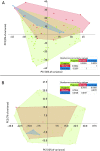Impact of the early-life skin microbiota on the development of canine atopic dermatitis in a high-risk breed birth cohort
- PMID: 31974513
- PMCID: PMC6978374
- DOI: 10.1038/s41598-020-57798-x
Impact of the early-life skin microbiota on the development of canine atopic dermatitis in a high-risk breed birth cohort
Abstract
Canine atopic dermatitis (CAD) is a prevalent inflammatory skin disease of dogs worldwide. Certain breeds such as the West Highland White Terriers (WHWT) are predisposed to suffer from CAD. Microbial dysbiosis is known to play a significant role in the pathogenesis of the disease, which is similar to its human counterpart, atopic dermatitis (AD). To date, no large cohort-study has been conducted in a predisposed dog breed to study the impact of the early-life microbiota on the development of CAD, as well as the possible implication of factors such as hygiene and access to the outdoors. In this study skin samples of 143 WHWT, including 109 puppies up to three weeks old and 34 parent dogs, from 17 breeders, were subjected to 16S rRNA gene and ITS2 amplicon sequencing to disclose the bacterial and fungal oral and skin microbiota, respectively. The oral samples served as a control group to confirm differences between haired and mucosal surfaces. The cutaneous microbiota differed between sample sites and age of the dogs. The season of sampling, geographical origin as well as hygiene status of the household and the access to the outdoors shaped the skin microbiota of the puppies significantly. However, we found that the individual early-life microbiota did not predispose for the later development of CAD.
Conflict of interest statement
The authors declare no competing interests.
Figures




References
-
- Lund EM, Armstrong PJ, Kirk CA, Kolar LM, Klausner JS. Health status and population characteristics of dogs and cats examined at private veterinary practices in the United States. J. Am. Vet. Med. Assoc. 1999;214:1336–1341. - PubMed
Publication types
MeSH terms
Substances
LinkOut - more resources
Full Text Sources
Other Literature Sources
Medical
Miscellaneous

